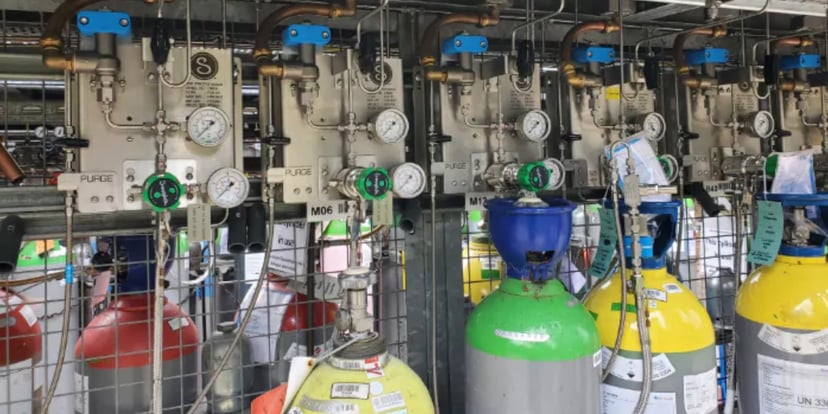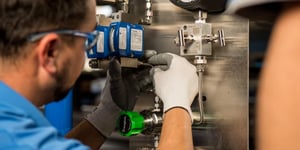Share this
Why Your Gas Panel Design Layout Matters in Northern California Refineries
by Malik Durojaiye on 5/18/21 9:00 AM

A well-designed gas distribution system will reduce your operating costs by consistently and safely delivering the required gas(es) at the optimum pressure(s) and minimizing manual tasks associated with system and cylinder management. Of course, every component of a gas distribution system is critical to reliable and safe operations, but the gas panel design layout, in my opinion, has the greatest impact on operating efficiency. While helping Northern California refineries with gas distribution systems, I’ve found that efforts invested in determining the best gas panel design layout more than pays off—it results in easier operations and greater reliability.
To arrive at the best gas panel design layout, you’ll need to assess the specific requirements of the process, beginning with the type of gas, understand the point of use application, and evaluate the existing or planned infrastructure.
Key Factors Influencing Gas Panel Design Layout
Gas panels can be underwhelmingly simple, extremely complex, and every variation between those extremes. Consider the range of factors that influence the gas panel layout design.
Number of Gases
Working with a single gas (such as nitrogen) to blanket tanks, requires a simpler design than delivering several different gases, such as hydrogen chloride or NOx for calibration at an analyzer station. The first may require a single pressure regulator to deliver nitrogen on-demand to an empty tank. The second involves a manifold connected to each of the different gas cylinders and controls to deliver each of the gases in sequence to the analyzer.
Delivery
If the application requires a continuous supply of gas, the panel will need to coordinate a smooth changeover from a primary to a secondary source when the primary source pressure equals the set changeover pressure. If the supply can be interrupted, panel design is much simpler. The physical space allocated for gas cylinders (one to many) also determines how frequently the cylinders need to be changed out. Gas panel design should help facilitate a smooth change-out process.
Pressure
Gas panels transform input pressure into a consistent output pressure. Use pressure regulators with sufficient range to meet process specifications while minimizing the supply-pressure effect. To counter the problems of unexpected pressure increases in a system, vent and relief options should be included in the panel design.
Safety
Industrial gases used in a refinery can be toxic, reactive, flammable, explosive, and cryogenic. It’s imperative that these gases are managed safely from source to point of use. Gas leakage can result in asphyxiation, suffocation or poisoning of personnel working in enclosed spaces. To avoid that risk, enclosed spaces that contain gas panels must have an operating exhaust system. Gas panels controlling the delivery of different gases need to ensure that incompatible gases are not mixed. If toxic calibration gases need to be purged from lines, purge time and volume need to be factored into the design.
New or existing infrastructure
In Northern California refineries, new or upgraded gas panels most likely need to be retrofitted into existing space. That usually means you’re working within physical constraints. Ordering components from a catalog and fabricating the panel on-site might work, but you’re better off working with an experienced field engineer who can conduct an onsite consultation to evaluate the need and then develop the gas panel design layout optimized to work within existing constraints.
How To Achieve Good Gas Panel Design Layout
A properly designed gas panel factors in key requirements such as gases and their properties, maximum inlet pressure, outlet control range, and any infrastructure constraint. That information determines the type and diameter of tubing, location of pressure gauges, whether single- or dual-stage pressure regulators are used, and the need for filters or pressure relief valves to safely and reliably deliver gas while minimizing the supply-pressure effect to the point of use.
While you might be tempted to make some preliminary calculations regarding the requirements for a new or updated gas distribution system and use that information to order components from a supplier’s catalog, you’ll come out ahead if you engage with a field engineer who specializes in gas panel design layouts for refineries.
With years of experience in designing gas distribution systems and an in-depth understanding of how process parameters can influence panel design, they are able to quickly design a gas panel layout customized for the requirements of the process. Good gas panel design layout not only facilitates safe operations, but the layout of the panel also provides easy access to components to minimize downtime whenever maintenance may be required.
Swagelok Expertise For Northern California Refineries
 Swagelok Northern California is conveniently located in the Bay Area and has decades of experience when it comes to assisting refineries with gas distribution systems. Our experienced field engineers can work with your engineering, operations, and HSE teams to design gas panels and distribution systems fine-tuned to the needs of each process.
Swagelok Northern California is conveniently located in the Bay Area and has decades of experience when it comes to assisting refineries with gas distribution systems. Our experienced field engineers can work with your engineering, operations, and HSE teams to design gas panels and distribution systems fine-tuned to the needs of each process.
At Swagelok, we design gas distribution systems based on best practices. Our modular panels minimize threaded connections to reduce potential leak points and are intuitively labeled for safe, simple operations and maintenance. All gas distribution systems are backed by the Swagelok Limited Lifetime Warranty.
To find out more about how Swagelok Northern California can help you determine the gas panel design layouts appropriate for your refinery processes by providing expert consultation, design, and fabrication, contact our team today by calling 510-933-6200.
-1.jpg?width=192&name=image8%20(1)-1.jpg) About Malik Durojaiye | Field Engineer, Assembly Services
About Malik Durojaiye | Field Engineer, Assembly Services
Malik Durojaiye began his Swagelok career in 2019 as a Custom Solutions Engineer in our Assembly Services group. Prior to Swagelok, Malik developed as a design engineer as well as a manufacturing engineer for 6 years serving Kentucky and California with Altec Industries; a leading provider of products and services to the electric utility, telecommunications, tree care, lights and signs, and contractor markets.
Share this
- Archive (465)
- Assembly Services (207)
- About (100)
- Seal Support Systems (96)
- Best Practices (88)
- Training Services (74)
- Fittings (51)
- Semiconductor Applications (49)
- Hoses and Flexible Tubing (47)
- Regulators (44)
- Tubing (42)
- Grab Sampling Systems (32)
- Sampling Systems (32)
- Gas Systems (30)
- Services (30)
- Downloads (29)
- Valves (24)
- Application Support (18)
- Orbital Welding (17)
- Case Studies (13)
- Steam Systems (13)
- Frequently Asked Questions (12)
- Tools (12)
- Measurement Devices (7)
- Subsystems (6)
- Thermal Management (6)
- September 2023 (1)
- August 2023 (2)
- June 2023 (1)
- March 2023 (3)
- February 2023 (3)
- January 2023 (4)
- December 2022 (4)
- November 2022 (4)
- October 2022 (4)
- September 2022 (1)
- August 2022 (3)
- July 2022 (2)
- June 2022 (4)
- May 2022 (1)
- April 2022 (2)
- March 2022 (1)
- February 2022 (2)
- January 2022 (3)
- December 2021 (1)
- November 2021 (6)
- October 2021 (6)
- September 2021 (8)
- August 2021 (4)
- July 2021 (3)
- June 2021 (6)
- May 2021 (6)
- April 2021 (7)
- March 2021 (5)
- February 2021 (4)
- January 2021 (6)
- December 2020 (5)
- November 2020 (6)
- October 2020 (6)
- September 2020 (8)
- August 2020 (7)
- July 2020 (8)
- June 2020 (8)
- May 2020 (6)
- April 2020 (9)
- March 2020 (7)
- February 2020 (10)
- January 2020 (21)
- December 2019 (23)
- November 2019 (21)
- October 2019 (22)
- September 2019 (21)
- August 2019 (22)
- July 2019 (23)
- June 2019 (20)
- May 2019 (23)
- April 2019 (22)
- March 2019 (21)
- February 2019 (20)
- January 2019 (21)
- December 2018 (14)
- November 2018 (19)
- October 2018 (23)
- September 2018 (17)
- August 2018 (29)
- July 2018 (11)
- June 2018 (6)
- May 2018 (5)
- April 2018 (4)
- March 2018 (5)
- February 2018 (3)
- January 2018 (3)
- December 2017 (2)
- November 2017 (4)
- October 2017 (3)
- September 2017 (2)
- August 2017 (6)
- July 2017 (4)
- June 2017 (4)
- May 2017 (4)
- April 2017 (3)
- March 2017 (4)
- February 2017 (3)
- January 2017 (3)
- December 2016 (3)
- November 2016 (3)
- October 2016 (3)
- September 2016 (5)
- August 2016 (5)
- July 2016 (4)
- June 2016 (5)
- May 2016 (3)
- April 2016 (4)
- March 2016 (5)
- February 2016 (11)
- January 2016 (1)
- December 2015 (3)
- November 2015 (4)
- October 2015 (3)
- September 2015 (4)
- August 2015 (4)
- July 2015 (8)
- June 2015 (5)
- May 2015 (3)
- April 2015 (4)
- March 2015 (4)
- February 2015 (3)
- January 2015 (4)
- December 2014 (2)
- November 2014 (3)
- October 2014 (4)
- September 2014 (4)
- August 2014 (4)
- July 2014 (5)
- June 2014 (4)
- May 2014 (4)
- April 2014 (5)
- March 2014 (4)
- February 2014 (3)
- January 2014 (4)
- December 2013 (5)
- November 2013 (3)
- October 2013 (4)
- September 2013 (3)
- August 2013 (5)
- July 2013 (5)
- June 2013 (5)
- May 2013 (3)
- April 2013 (6)
- March 2013 (4)
- February 2013 (4)
- January 2013 (8)
- December 2012 (4)
- November 2012 (6)
- October 2012 (6)
- September 2012 (4)
- August 2012 (4)
- July 2012 (4)
- June 2012 (4)

.webp?width=210&height=70&name=StickyLogo%20(5).webp)